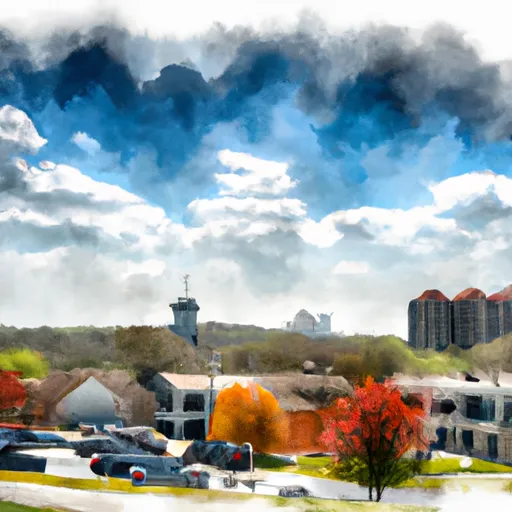-
 Snoflo Premium
Snoflo Premium
Get unlimited access to all our content
With no Ad interruptions! - Start Your Free Trial Login with existing account
Landover-Hills
Eden Index
Climate
8.3
•
Recreation
6.6
•
Community
3.0
•
Safeguard
6.3/10

Landover Hills is a small town located in Prince George's County, Maryland. The region experiences a humid subtropical climate, characterized by hot, humid summers and mild winters. Summers see temperatures ranging from 75°F to 90°F, while winters average between 30°F to 50°F. Precipitation is relatively evenly distributed throughout the year, with an average annual rainfall of around 45 inches.
The town does not have any major water bodies within its boundaries; however, it is situated near the Anacostia River and the Patuxent River. These nearby rivers offer opportunities for fishing, boating, and other water-based activities. Greenbelt Lake, located a short drive away, provides additional recreational opportunities, including hiking, picnicking, and wildlife observation.
Landover Hills itself features several parks and open spaces, offering residents and visitors outdoor recreational options. Highland Park, for example, offers amenities such as playgrounds, sports fields, and walking trails. The town's proximity to the larger cities of Washington, D.C., and Baltimore also provides easy access to a wide range of outdoor activities, including hiking, biking, and exploring national parks and forests within a short drive.
What is the Eden Index?
The Snoflo Eden Index serves as a comprehensive rating system for regions, evaluating their desirability through a holistic assessment of climate health, outdoor recreation opportunities, and natural disaster risk, acknowledging the profound impact of these factors on livability and well-being.
Climate Health Indicator (CHI): 8.3
Landover-Hills receives approximately
1125mm of rain per year,
with humidity levels near 80%
and air temperatures averaging around
14°C.
Landover-Hills has a plant hardyness factor of
7, meaning
plants and agriculture in this region tend to thrive during the non-winter months.
By considering the ideal temperature range, reliable water supplies, clean air, and stable seasonal rain or snowpacks, the Climate Health Indicator (CHI) underscores the significance of a healthy climate as the foundation for quality living.
A healthy climate is paramount for ensuring a high quality of life and livability in a region, fostering both physical well-being and environmental harmony. This can be characterized by ideal temperatures, reliable access to water supplies, clean air, and consistent seasonal rain or snowpacks.
Weather Forecast
Streamflow Conditions
Potomac
Area Rivers
Potomac
Snowpack Depths
Potomac
Reservoir Storage Capacity
Potomac
Groundwater Levels
Recreational Opportunity Index (ROI): 6.6
The Recreational Opportunity Index (ROI) recognizes the value of outdoor recreational options, such as parks, hiking trails, camping sites, and fishing spots, while acknowledging that climate plays a pivotal role in ensuring the comfort and consistency of these experiences.
Access to outdoor recreational opportunities, encompassing activities such as parks, hiking, camping, and fishing, is crucial for overall well-being, and the climate plays a pivotal role in enabling and enhancing these experiences, ensuring that individuals can engage in nature-based activities comfortably and consistently.
Camping Areas
| Campground | Campsites | Reservations | Toilets | Showers | Elevation |
|---|---|---|---|---|---|
| Cedarville State Forest | 27 | 198 ft | |||
| Greenbelt Park | 175 | 121 ft | |||
| Andrews AFB Military | None | 269 ft | |||
| Louise F. Cosca Regional Park | 23 | 223 ft |
Nearby Ski Areas
Catastrophe Safeguard Index (CSI):
The Catastrophe Safeguard Index (CSI) recognizes that natural disaster risk, encompassing floods, fires, hurricanes, and tornadoes, can drastically affect safety and the overall appeal of an area.
The level of natural disaster risk in a region significantly affects safety and the overall livability, with climate change amplifying these risks by potentially increasing the frequency and intensity of events like floods, fires, hurricanes, and tornadoes, thereby posing substantial challenges to community resilience and well-being.
Community Resilience Indicator (CRI): 3.0
The Community Resilience Indicator (CRI) recognizes that education, healthcare, and socioeconomics are crucial to the well-being of a region. The CRI acknowledges the profound impact of these elements on residents' overall quality of life. By evaluating educational resources, healthcare accessibility, and economic inclusivity, the index captures the essential aspects that contribute to a thriving community, fostering resident satisfaction, equity, and social cohesion.

